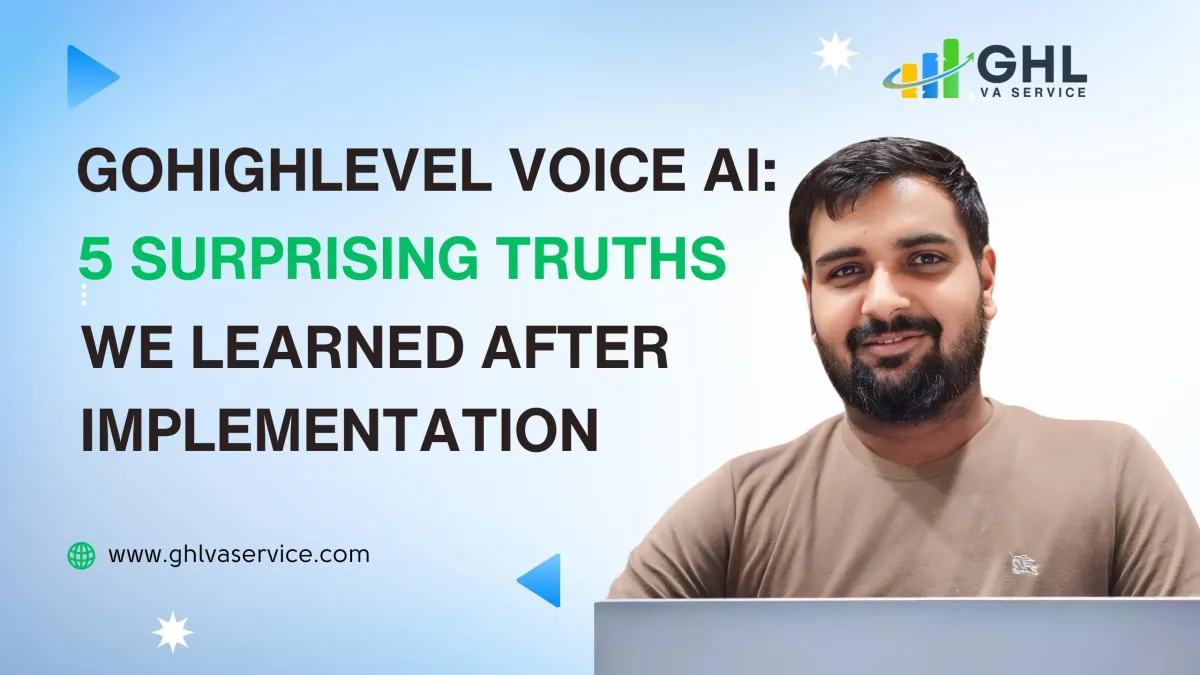
GoHighLevel Voice AI: 5 Surprising Truths We Learned After Implementation
Introduction: The Promise and the Reality of AI Sales Agents
Every business owner dreams of a "sales machine that never sleeps," an automated system engaging leads 24/7. GoHighLevel's Voice AI promises to make this a reality. But between the marketing promise and the on-the-ground implementation lies a series of strategic gaps-nuances that can make or break your success.
Like any powerful tool, its true potential is only unlocked when you understand its specific rules of engagement. This guide moves beyond the surface-level features to reveal the five most critical takeaways we learned firsthand, exposing the surprising limitations and impactful capabilities you need to master.
Watch Now👇
Takeaway 1: Your Phone System is a Bigger Deal Than You Think

1. It Only Works With GHL's Own Phone System (But Has a Silver Lining)
The first and most critical point is that the Voice AI agent works exclusively with the "LC phone system" (short for LeadConnector, GoHighLevel's native phone provider). It explicitly will not function with Twilio or any other external phone number you might bring into the platform.
However, this limitation comes with a counter-intuitive silver lining: you do not need A2P 10DLC verification for voice calls. Many users get confused by this, but A2P is only required for sending SMS from US and Canadian numbers. You can receive incoming calls and have the Voice AI function perfectly without it.
This isn't just a technical prerequisite; it's the first strategic checkpoint. Misunderstanding this can waste hours of configuration and lead to frustrating client conversations before the project even begins. Clarifying the LC phone requirement and the A2P non-requirement upfront positions you as an expert and sets clear, achievable expectations from day one.
Takeaway 2: The "80% Rule" of Prompt Engineering
2. Forget the Settings-80% of Your Success Lives in the Prompt
While the Voice AI offers numerous advanced settings for voice tone, speed, and interruption sensitivity, the single most critical factor for its accuracy is the quality of the written instructions, known as the prompt.
This insight from the implementation process is a game-changer:
I personally believe that 80% of the accuracy of your voice AI agent depends on how good your prompt is.
GoHighLevel includes a built-in "evaluate" feature that helps you refine your instructions. After you write your prompt, this tool analyzes it for potential issues or ambiguities and provides specific feedback for improvement.
This insight re-frames success entirely. You cease to be a technician fiddling with dials and become a director instructing an actor. Your true leverage isn't in the settings panel; it's in the clarity and strategic intent of your words.
Takeaway 3: The Pricing Model Has a Clear Tipping Point
3. The Pricing Isn't One-Size-Fits-All: Know Your Break-Even Point
The Voice AI pricing has two distinct models, and choosing the right one depends entirely on your call volume.
Pay-as-you-go: $0.13 per minute
Unlimited Package: $97 per month
Crucially, the $97/month unlimited plan is charged per sub-account, not at the agency level. This means if you have ten clients who need it, you'll need ten separate unlimited plans.
The specific break-even point is 746 minutes. If you anticipate using more than 746 minutes of Voice AI in a single sub-account per month, the unlimited plan is more cost-effective. If you expect less, the pay-as-you-go model is the better choice. Knowing this exact number empowers you to make a clear, data-driven decision based on expected usage rather than guesswork.
Takeaway 4: It's Not Just an Answering Machine, It's an Action Engine

4. It Does More Than Talk-It Takes Action
The Voice AI's most powerful capabilities are found in its "Actions," which allow it to perform specific tasks during or after a call based on the conversation.
Here are the key actions the AI can perform:
Transfer Call to Human: Send the caller to a specific person if requested.
Trigger a Workflow: Add the caller to an automation sequence, such as a follow-up campaign.
Send an SMS: Instantly text a signup link or other information discussed on the call.
Update Contact Field: Gather and save information like the caller's full name and email directly to their contact record.
Appointment Booking: Check a connected calendar in real-time and book an appointment for the caller.
These aren't isolated commands; they are building blocks for a complete, automated customer journey. A single call can result in a captured lead, a booked appointment, and a follow-up text with a critical link-all without any human intervention. It doesn't just field calls; it moves leads forward.
Takeaway 5: There’s a Smart Way to Handle the "New Number" Objection
5. How to Overcome the #1 Client Objection: "I Don't Want a New Number"
The requirement for an LC phone number often leads to a common problem: existing businesses don't want to abandon the phone number they've advertised for years on their website, Google My Business profile, and print materials.
Here is a clear, three-step strategy to overcome this objection:
Reassure & Forward: Explain that the new LC phone number can simply be forwarded to their existing business line, ensuring they never miss a call. The Voice AI then acts as a perfect backup, only kicking in if they are unable to pick up.
Highlight the Benefits: Emphasize the unique advantages they gain by using the new number, such as having all calls automatically recorded and unlocking the full power of the AI agent to book appointments and capture lead data.
Provide a White-Glove Transition: For high-value clients, the best way to remove friction is to offer to do the work for them. Gain access to their website, social media, and Google profiles and switch the number yourself.
Beyond Answering Calls
True success with GoHighLevel's Voice AI requires five critical mindset shifts. You must shift from thinking any phone to native-only, from tweaking settings to mastering language, from guessing on price to knowing your break-even, from passive answering to active automation, and from client friction to a white-glove transition.
By internalizing these strategic realities, you can build more than just a 24/7 answering service-you can build a true automation engine.
Now that you see the possibilities, how will you use Voice AI to not just answer calls, but to actively build a more automated and efficient business?



